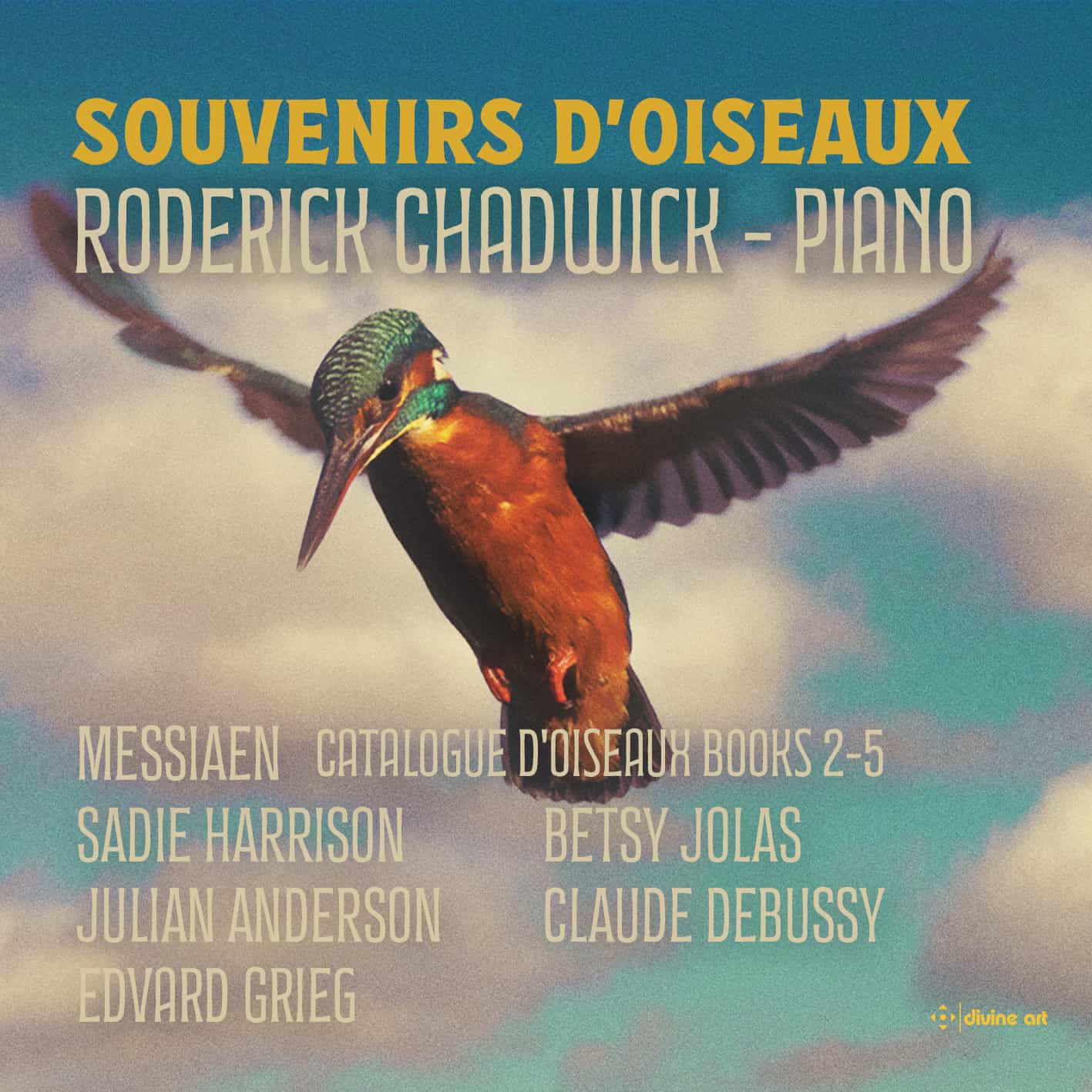Fanfare
In Fanfare 44:3 Peter Rabinowitz favorably reviewed Roderick Chadwick’s recording of Book 1 of Olivier Messiaen’s Catalogue d’oiseaux. The only complaint that Rabinowitz expressed was that Chadwick “has only given us a small portion of the complete work.” This new release addresses that issue by giving us four more books from this extraordinary cycle of piano pieces. It seems reasonable to assume that the final two books are still to come. Chadwick has separated each of Messiaen’s four books with music by other composers that is related specifically to birds or more generally to Nature. The result is highly imaginative and captivating.
Chadwick was co-author with Peter Hill of Olivier Messiaen’s Catalogue d’oiseaux: From Conception to Performance, published in 2017. His intimate familiarity with the music shows throughout his playing. It is not surprising that most of the existing recordings of Catalogue d’oiseaux are very good. Only a pianist with a fierce dedication to this difficult and highly unusual music would bother to learn and perform it. Thus there are fine recordings by Yvonne Loriod (the composer’s wife and dedicatee of the cycle), Pierre-Laurent Aimard, and Peter Hill, among others. Chadwick joins that upper level.
Although Messiaen’s fascination with birdsong is well known, this cycle is much more than a transcription of bird calls. It is not necessary, or even advisable, to listen with the purpose of identifying specific birds. Rather, one should hear it as an exploration of all that Nature has to offer—daylight, sundown, sunrise, wind, cool breezes, and the vastness of the universe. Messiaen’s sound world is different from any other composer’s, although he was strongly influenced by Debussy. For me, the way to listen to Catalogue d’oiseaux is to just let the music sweep over you, to absorb it as a discovery in sound.
This cycle is extraordinarily difficult to bring off in performance. It requires a prodigious technique, a wide palette of colors, and the full spectrum of dynamic shadings in order to capture Messiaen’s boundless imagination. There are moments of extraordinary delicacy along with moments of enormous power. The qualities that make Chadwick’s performance compelling include its beauty in quiet passages, Chadwick’s accuracy and clarity in the most rapid passagework and repeated notes, and the majesty of the mystical sections.
In his superb and extensive program notes, Chadwick writes: “The remaining pieces on this recording are configured with the aim of complementing the masterpiece at the heart of Catalogue d’oiseaux, and to enhance the sense of day night continuum that is established throughout the Catalogue’s interior Livres.” Sadie Harrison is an Australian composer (b. 1965) whose lovely Lunae: Four Nocturnes is more traditional in its sound world. These Nocturnes are clearly in the tradition of Chopin, although there are hints of Debussy and Messiaen in the third, “Of Stars and Nightingales.” Individually or as a group, Harrison’s pieces would make an attractive addition to the recital repertoire of any pianist.
Julian Anderson is a British composer (b. 1967) whose Sensation was premiered by Pierre-Laurent Aimard at the Aldeburgh Festival in 2016, and then as part of the Santa Fe Chamber Music Festival the following year. The six-movement cycle encompasses almost as wide a range of colors as Messiaen’s Catalogue, though I find much less unity in Anderson’s work. The longest movement is titled “Alba.” According to the composer it is “a celebration of the sounds and sensations of dawn and the return of sunlight in increasingly bright, radiant bell chords and resonances. These grow in intensity and resonance until they cover every register of the piano.” I fear that to me it seemed a series of disconnected sounds. Other listeners will probably find more shape and coherence in the music than I do.
Betsy Jolas is a French-American composer, born in Paris in 1926 to an American couple who returned to the U.S. in 1940. Jolas went back to Paris in 1946 and studied at the Conservatoire with Darius Milhaud and Messiaen. In the 1970s she became an assistant to Messiaen, and the influence of him on her music is clear in Chanson d’approche, although the music is more pointillistic than her teacher’s. The textures of this piece are spare, and Chadwick conveys the music’s delicacy beautifully.
The inclusion of Debussy and Grieg on the program is more than a concession to listeners who might like something familiar. The influence of Debussy on Messiaen is often written about, and including a brief Debussy Prélude clarifies that relationship. The “Notturno” from Grieg’s Lyric Pieces might seem less related, but in fact the replication of delicate bells and a trilling bird call show a closer connection that one might have imagined.
The recorded sound is utterly natural, with a perspective that is neither too close nor too distant. Everything is clear, but there is also plenty of ambience. This is an extremely successful recording that will reward the curious listener along with devotees of Messiaen.
@divineartrecordingsgroup
A First Inversion Company
Registered Office:
176-178 Pontefract Road, Cudworth, Barnsley S72 8BE
+44 1226 596703
Fort Worth, TX 76110
+1.682.233.4978










![Listen to the full suite of Marcel Dupré’s Variations Sur un Noël, Op. 20 from Alexander Ffinch’s #Expectations release today! listn.fm/expectations [in bio]](https://scontent-dfw5-1.cdninstagram.com/v/t51.71878-15/588904367_2327488161082898_8709236950834211856_n.jpg?stp=dst-jpg_e35_tt6&_nc_cat=105&ccb=7-5&_nc_sid=18de74&efg=eyJlZmdfdGFnIjoiQ0xJUFMuYmVzdF9pbWFnZV91cmxnZW4uQzMifQ%3D%3D&_nc_ohc=H8WFKm530VcQ7kNvwFViZNM&_nc_oc=AdmC92c2HnvaxbulJtGgTVx0xZDxd--1AT5fOqddWOXsKwgWg7hRu5JYz3YWQwyE4Fk&_nc_zt=23&_nc_ht=scontent-dfw5-1.cdninstagram.com&edm=ANo9K5cEAAAA&_nc_gid=AbuBhQ8aJuc33in7D9siRA&oh=00_Afm0_zMsrQndCoTQgCIk6TTC2WAZp2O9khTpBvzHIYWvnQ&oe=6955692A)

![“the ‘Manteca’ Paraphrase – a rare foray into the two-piano medium but here played double-tracked – exudes a panache of which Dizzy Gillespie would surely have approved.… [a] recital well worth investigating.” —Gramophone Magazine with high praise for Ophelia Gordon's debut release, Kapustin: Between the Lines!](https://scontent-dfw5-3.cdninstagram.com/v/t51.82787-15/598796470_18303255136283342_540941604740887837_n.jpg?stp=dst-jpg_e35_tt6&_nc_cat=108&ccb=7-5&_nc_sid=18de74&efg=eyJlZmdfdGFnIjoiRkVFRC5iZXN0X2ltYWdlX3VybGdlbi5DMyJ9&_nc_ohc=IC4zZ7tcpb8Q7kNvwGzjzWB&_nc_oc=Adn34P8TdpeC12GlORj6HX2a1qXgslFr_0ziiKbh-Sk4bL4eRRshNuJwJ-pr5yYvDAI&_nc_zt=23&_nc_ht=scontent-dfw5-3.cdninstagram.com&edm=ANo9K5cEAAAA&_nc_gid=AbuBhQ8aJuc33in7D9siRA&oh=00_AfkubUQrdJd3aPQOaUXwifQNyHS_GWrpgjRyeh5E7VsyHw&oe=69554384)